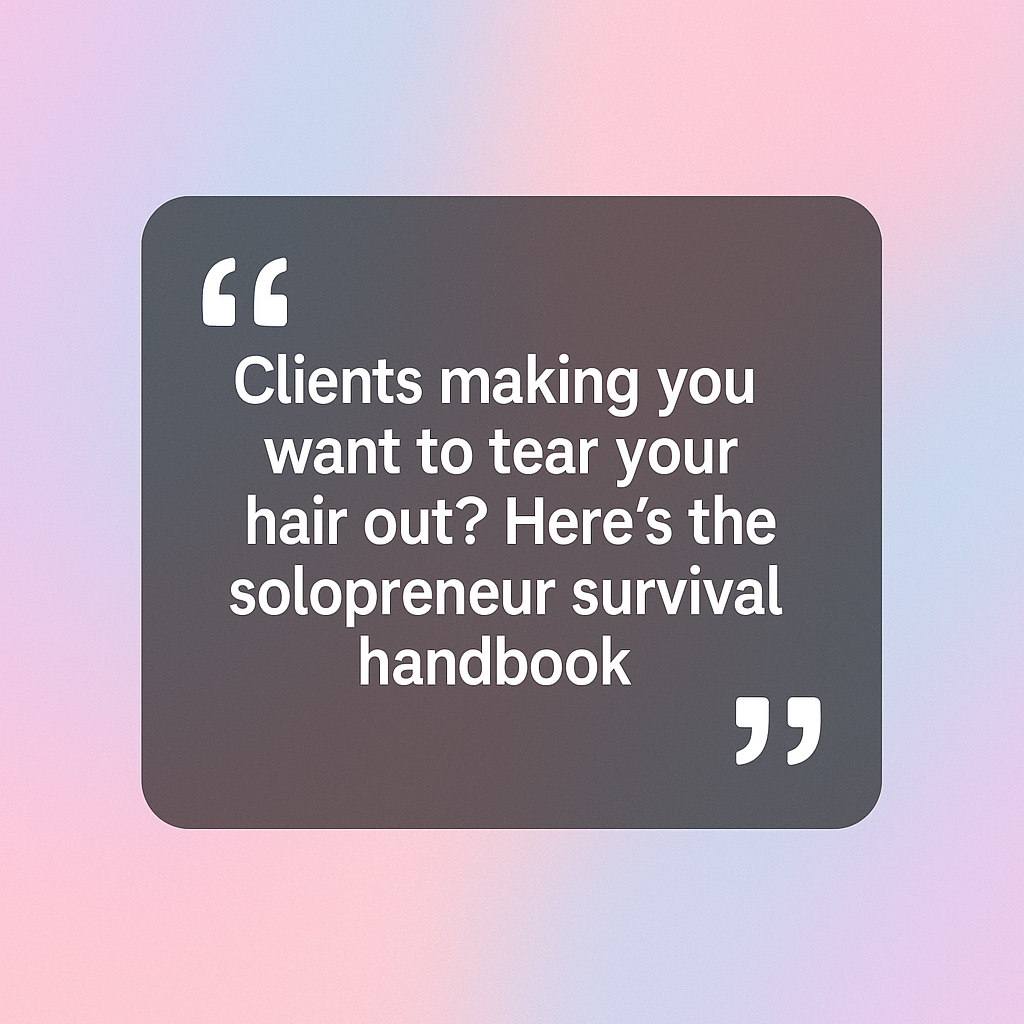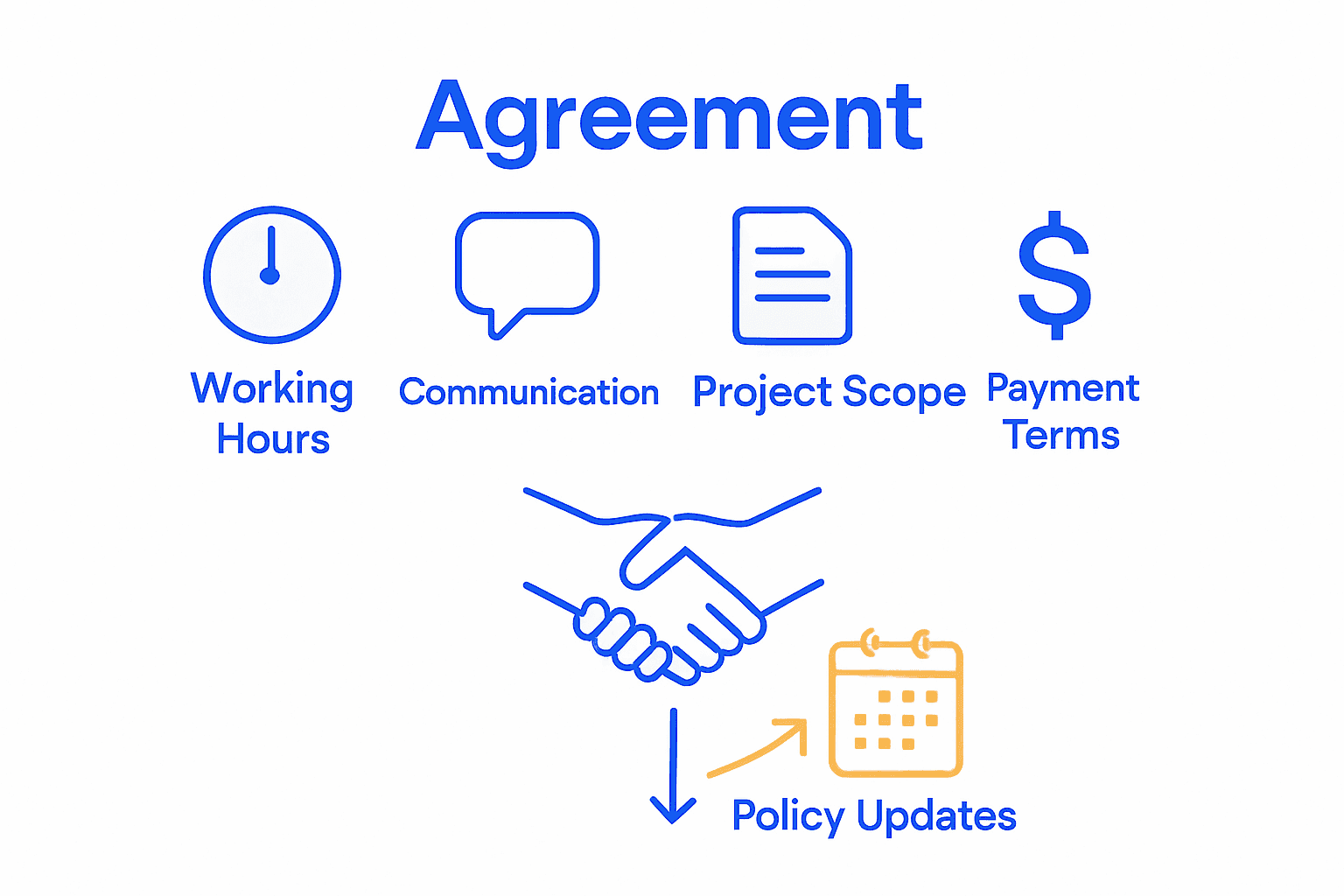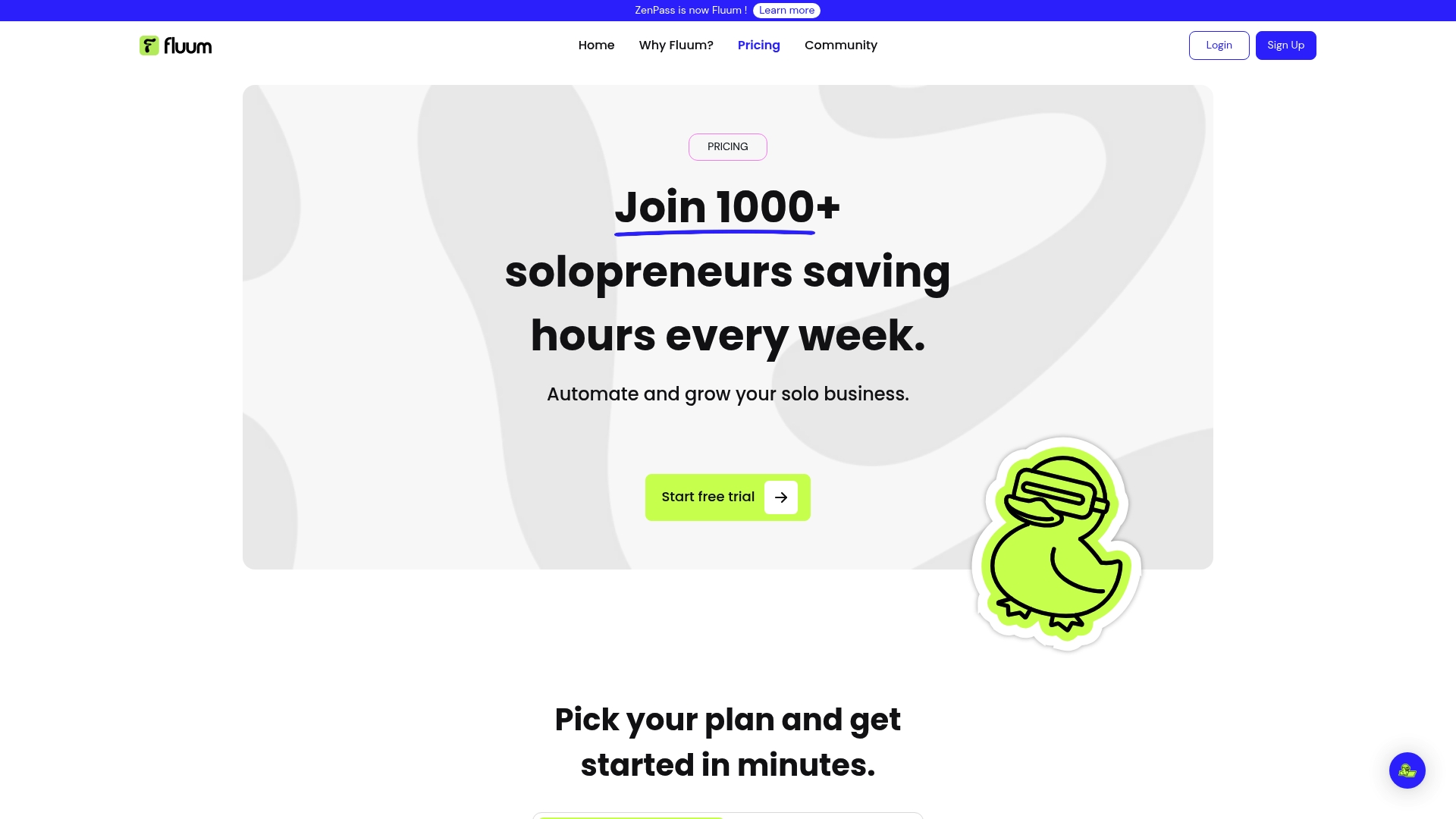
How to handle difficult clients is fundamental as solopreneurs. Over 65 percent of solopreneurs say client management challenges drain their energy and slow growth. Running a solo business means every interaction carries weight, and even one difficult client can disrupt your progress. Learning to spot early warning signs, set clear boundaries, and communicate with confidence helps you protect your time and reputation while building strong, productive client relationships.
Table of Contents
- Step 1: Identify Early Client Warning Signs
- Step 2: Establish Clear Communication Channels
- Step 3: Set And Reinforce Professional Boundaries
- Step 4: Implement Structured Conflict Resolution
- Step 5: Review Results And Refine Your Process
Quick Summary
| Key Point | Explanation |
|---|---|
| 1. Identify early client warning signs | Watch for red flags during initial interactions to avoid difficult client relationships. |
| 2. Establish clear communication channels | Use multiple communication tools to set professional expectations and reduce misunderstandings. |
| 3. Set professional boundaries | Define working hours, response times, and project scope to protect your time and integrity. |
| 4. Implement structured conflict resolution | Develop a clear process for handling client conflicts to maintain professional relationships. |
| 5. Review results and refine your process | Regularly assess client interactions and adjust strategies based on feedback and performance metrics. |
Step 1: Identify early client warning signs
As a solopreneur, how to handle difficult clients effectively and detecting potential client challenges before they escalate can save you significant time, energy, and stress. This step will help you recognize red flags during initial interactions that might signal a difficult client relationship.
Start by paying close attention during your first communications. Warning signs often emerge in how potential clients communicate and interact with you. Watch for communication patterns that suggest potential problems. Do they respond with excessive criticism? Are their emails demanding or disrespectful? Do they constantly push boundaries or seem unreasonable in their initial requests?
Look for specific behavioral indicators that might predict future challenges:
Here’s a comparison of early client warning signs and why they matter:
| Red Flag Behavior | Why It Matters |
|---|---|
| Extreme price sensitivity | Signals undervaluing your work |
| Vague/changing project requirements | Indicates potential scope creep |
| Reluctance to give clear specifications | May cause delays and confusion |
| Unrealistic expectations | Leads to dissatisfaction risks |
| Aggressive negotiation or rate undermining | Threatens your professional value |
- Extreme price sensitivity without understanding value
- Vague or constantly changing project requirements
- Reluctance to provide clear project specifications
- Multiple unrealistic expectations during initial discussions
- Aggressive negotiation tactics or attempts to undermine your professional rates
Trust your professional instincts. If something feels off during initial conversations, it probably is. Most difficult client relationships can be predicted through careful observation of early interactions.
Pro Tip: Document your initial interactions. If red flags emerge, you will have a clear record of communication patterns that helped you make an informed decision about working together.
Remember that declining a potentially problematic client is not just acceptable it is a strategic business decision that protects your professional energy and reputation.
Step 2: Establish clear communication channels
Creating robust communication channels is critical for managing client relationships and setting professional expectations. According to LinkedIn research on solopreneur time management, mastering digital communication platforms helps reduce misunderstandings and improve overall client interactions.
Start by selecting the right communication tools that match your professional workflow. As Business Age research suggests, solo entrepreneurs are moving beyond traditional email to more dynamic communication platforms that organize messages by urgency and medium.
Consider implementing a multi-channel communication strategy:
- Primary email for formal communications and documentation
- Project management tool for detailed task tracking
- Scheduling software for appointment bookings
- Messaging app for quick check ins and urgent updates
- Video conferencing platform for complex discussions
Set clear expectations from the beginning. Communicate your typical response times, preferred contact methods, and communication boundaries. This transparency helps clients understand how and when they can reach you professionally.
Pro Tip: Create a standard onboarding document that outlines your communication protocols. This helps set expectations and demonstrates your professionalism from the first interaction.
Adapt your communication style based on each client. Some prefer detailed emails while others appreciate concise messages. Flexibility shows your commitment to effective collaboration.
By establishing structured yet flexible communication channels, you create a framework for smooth client interactions that respect both parties professional time and expectations.
Step 3: Set and reinforce professional boundaries
Drawing clear lines between your professional services and personal space is crucial for long-term success as a solopreneur. According to Sagan Morrow, boundary issues typically emerge from solopreneurs not establishing firm expectations from the start.
Begin by defining your professional parameters comprehensively. This means explicitly outlining your working hours, communication protocols, project scopes, and response expectations. As Audacious Evolution research highlights, clear policies protect your professional integrity and prevent potential client overreach.
Key boundaries to establish include:
- Specific working hours and availability
- Maximum response time for communications
- Clear project scope and deliverable definitions
- Payment terms and late payment consequences
- Limits on revision rounds and additional work
Document these boundaries in a formal client agreement or onboarding document. This written record serves as a reference point and demonstrates your professionalism.

When clients understand expectations upfront, misunderstandings become less likely.
Pro Tip: Review and update your boundary policies annually. As your business evolves, your professional boundaries might need refinement.

Master Setting Boundaries With Clients For Success can provide additional insights into maintaining healthy client relationships.
Remember that enforcing boundaries is not about being rigid but about creating mutual respect. Communicate your limits kindly yet firmly. Your goal is creating a professional environment where both you and your clients feel comfortable and valued.
Step 4: Implement structured conflict resolution
Creating a systematic approach to managing client conflicts is essential for maintaining professional relationships and protecting your business reputation. According to Paymo App’s professional guide, developing standard operating procedures for problem resolution helps reduce ad-hoc reactions and provides a consistent framework for addressing challenges.
Start by developing a clear conflict resolution workflow that outlines specific steps for handling different types of client disagreements. Your protocol should include objective assessment methods that allow you to analyze issues without emotional reactivity. This means creating a structured approach that prioritizes facts and professional communication.
Your conflict resolution framework should incorporate these critical elements:
- Initial acknowledgment of the client’s concern
- Systematic gathering of relevant project information
- Objective evaluation of the dispute
- Proposed resolution options
- Clear documentation of the resolution process
- Follow-up mechanism to ensure client satisfaction
Practice active listening during conflict scenarios.
This means hearing the client’s perspective completely before formulating your response. Validate their feelings while maintaining professional boundaries and focusing on finding constructive solutions.
Pro Tip: Always maintain a calm and professional tone. Emotional reactivity can escalate conflicts and damage professional relationships.
Document each conflict resolution interaction. This creates a historical record that can help you identify patterns and improve your processes over time. Treat each conflict as a learning opportunity to refine your professional approach.
Remember that effective conflict resolution is not about winning an argument but finding a mutually acceptable path forward that preserves the professional relationship and your business integrity.
Step 5: Review results and refine your process
Continuous improvement is the cornerstone of successful client management for solopreneurs. According to Paymo App’s professional insights, developing and updating standard operating procedures based on accumulated experience enables iterative refinement of your client interaction strategies.
Implement a systematic review process that allows you to analyze your client interactions objectively. This means tracking key metrics such as client satisfaction rates, project completion times, communication effectiveness, and resolution speed for potential conflicts.
Your review process should include:
- Quarterly performance assessments
- Client feedback collection
- Analysis of communication patterns
- Identification of recurring challenges
- Documented process improvements
- Skill development based on insights
As Kenny Yarmosh’s comprehensive guide emphasizes, standardized methodologies help solopreneurs reduce burnout and increase interaction consistency. Create a template for reviewing your professional performance that allows you to spot trends and make strategic adjustments.
Pro Tip: Treat your business processes like a living document. What works today might need refinement tomorrow.
Understanding Reviewing Business Performance For Success can provide additional strategies for comprehensive business evaluation.
Remember that refinement is not about self criticism but about continuous growth. Each review is an opportunity to become more efficient professional and deliver exceptional value to your clients.
Manage Difficult Clients with Confidence Using Smart Tools
Handling clients who push boundaries or bring unrealistic expectations can drain your energy and focus. This article highlights the importance of setting clear communication channels, enforcing professional boundaries, and having structured conflict resolution methods to protect your time and reputation. If you struggle with vague project requirements or aggressive negotiations, streamlining your client management process is critical.

Take control of your client relationships today with Fluum — the AI-powered platform designed precisely for solopreneurs like you. Centralize your communication, set clear expectations with easy onboarding templates, and manage bookings and payments all in one place. Don’t let difficult clients weigh you down. Explore our plans and start automating your business processes now at Fluum Pricing. Gain clarity, protect your professional boundaries, and grow confidently with tools tailored to your needs.
Frequently Asked Questions
How can I identify early warning signs of a difficult client?
You can identify early warning signs by paying attention to a potential client’s communication patterns during initial interactions. Look for excessive criticism, vague project requirements, or aggressive negotiation tactics. Document these behaviors to help decide whether to move forward with the client or not.
What steps should I take to establish clear communication with clients?
To establish clear communication, select the appropriate communication tools and set expectations from the beginning. Use a mix of email, project management tools, and messaging apps to ensure clarity in your interactions. Communicate your typical response times and contact methods to avoid misunderstandings.
How do I set and maintain professional boundaries with clients?
Set professional boundaries by defining your working hours, availability, and specific project scopes. Document these boundaries in a client agreement so that both you and the client understand the terms. Regularly review these boundaries and adjust as necessary to maintain professional integrity.
What is an effective method for resolving conflicts with clients?
Implement a structured conflict resolution process that includes acknowledging the client’s concern, gathering relevant information, and proposing resolution options. Practice active listening and keep a calm tone to de-escalate potential conflicts. Document the resolution steps for future reference and follow up to ensure client satisfaction.
How can I refine my client management process over time?
Refine your client management process by conducting quarterly performance assessments and gathering client feedback. Analyze communication patterns and document any recurring challenges you encounter. Use this information to make iterative improvements and enhance your overall client interaction strategies.
What should I do if I notice multiple red flags during initial client interactions?
If you notice multiple red flags, trust your instincts and consider declining the client relationship. Document your concerns so you can refer back to them later. This decision can help protect your professional energy and maintain your reputation for future projects.
Recommended
- Fluum | Effective Stress Management Techniques for Busy Professionals
- Fluum | How to Onboard Clients Effectively for Lasting Success
- Fluum | Master Managing Multiple Projects for Success
- Fluum | Build Your Brand with a Branding Builder in 2025
- Fluum | 7 Customer Retention Examples to Boost Your Business


